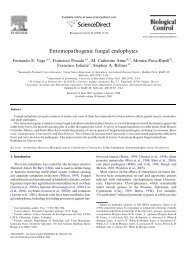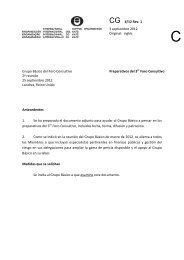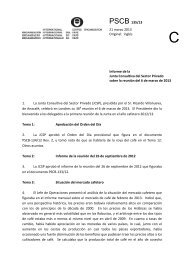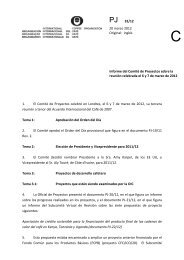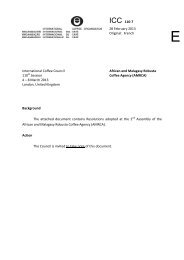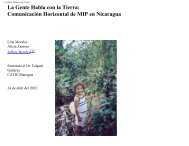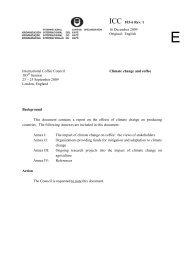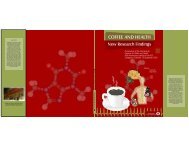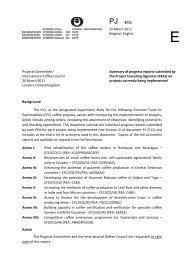Devouring profit - International Coffee Organization
Devouring profit - International Coffee Organization
Devouring profit - International Coffee Organization
You also want an ePaper? Increase the reach of your titles
YUMPU automatically turns print PDFs into web optimized ePapers that Google loves.
We have attempted to show that CBB is a very complex pest with many factors<br />
affecting both its abundance and control. In the following analysis we will integrate all<br />
the information we have gathered to formulate a strategic view of the problem.<br />
6.1 IPM strategy<br />
According to the <strong>International</strong> Pest Management Institute (2002), IPM is: “a system<br />
using multiple methods, a decision making process, a risk reduction system, information<br />
intensive, biological based, cost effective and site specific”. If this is a widely<br />
accepted definition it is very clear that IPM is a complex strategy to be understood and<br />
carried out by farmers whatever their socio-economic conditions. This approach implies<br />
a concerted effort by farmers to comprehend the relationships between the<br />
different components and concepts of IPM. We broadly support this approach to pest<br />
control but it needs to be made clear that IPM is neither easy to understand nor easy<br />
to carry out.<br />
Indeed we submit that the above description meshes uneasily with our own perceptions<br />
of resource-poor farmers’ present capabilities. Either IPM has to become easier<br />
to undertake or farmers will require intensive re-skilling.<br />
6.2 How IPM strategy clashes with<br />
socio-economic reality<br />
If we look at the requirements of IPM against farmers’ needs and abilities, we deduce<br />
that smallholder coffee farmers are not ready for IPM. It presupposes a certain level of<br />
education that is frequently lacking and a way of looking at things that is foreign.<br />
Intrinsically it is a very modern concept, a “knowledge intensive” solution and we<br />
believe it is emblematic of smallholders’ problems as they try to survive in a global<br />
economy, on the wrong side of the ‘digital divide’.<br />
IPM principally depends on measurement of pest levels and then calculations to estimate<br />
crop damage and then a decision by the farmer on whether to control or not,<br />
and if so which method to use. In its original form, it is predicated upon the farmer<br />
having at least secondary education and a fairly sophisticated knowledge of pest biology<br />
so that he can apply the correct control at the moment when the pest is at its most<br />
vulnerable or before it is at its most damaging. It is rooted in a certain ethic, where the<br />
farmer invests in knowledge, equipment and extra labour in the expectation of it<br />
saving him more in the long run than he expends.<br />
The problem is that this reasoning is not readily transportable to smallholder farmers<br />
with at most primary education, less than perfect confidence in experts and limited<br />
resources. What is worse, many scientists and extensionists who serve these farmers,<br />
have been taught about IPM as though it is an established fact and not something that<br />
is necessarily work-in-progress, questionable, negotiable or subject to revision.<br />
65




